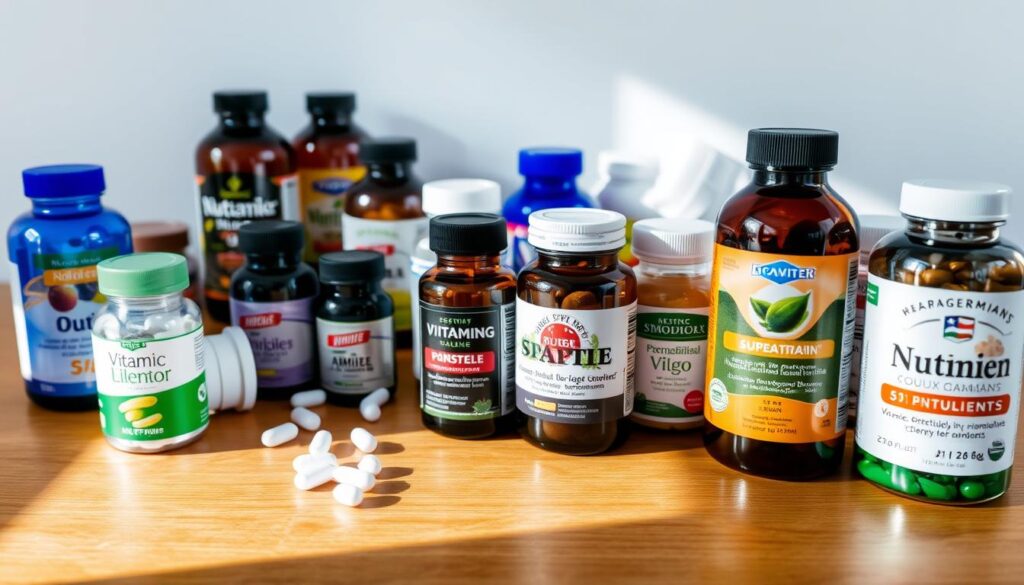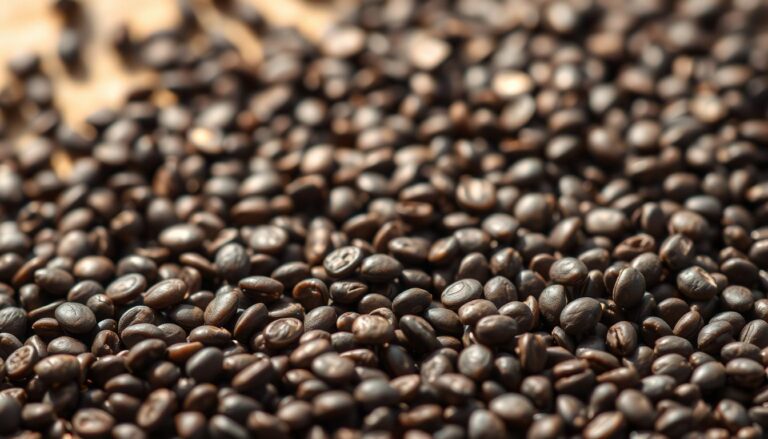Can a pill truly fill gaps in a busy diet or are most remedies just clever marketing?
Vitamin supplements aim to top up nutrition when food falls short. Many people buy them to support basic health, yet U.S. consumers spend about $60 billion a year on these products while robust evidence often lags behind marketing claims.
Dietary formulas are not FDA approved for safety or effectiveness before sale. That makes third‑party testing by USP or NSF an important check on quality and purity.
This guide will map proven benefits, realistic limits, and smart choices across common categories like fish oil calcium and D, B12, magnesium gut support and protein powders. We’ll also show when minerals and vitamins matter most life stages, diagnosed deficiencies, or restricted diets and why a food‑first approach matters.
Key Takeaways
- Many people buy supplements but spending far outpaces strong, peer‑reviewed evidence.
- Food first nutrition often reduces the need for extra products.
- Look for USP or NSF verification the FDA does not pre‑approve these items.
- Supplements help most when a deficiency or life stage requires them.
- This guide separates essential uses from hype and offers practical, evidence‑grounded advice.
Why Americans Turn to Vitamin supplements Today
Marketing and social media make it tempting to believe a pill will prevent chronic disease. That promise draws many people toward over the counter options for quick energy immune support, or long term disease prevention.
What science shows: Large studies and expert reviews often find limited benefit for broad outcomes like heart disease cancer, or cognitive decline. Johns Hopkins researchers note multivitamins have not reliably reduced these risks.
Key risks and practical steps Misleading claims variable product quality and harmful interactions are real concerns. Identify a specific need before you use a product. Verify third‑party testing and read labels for dose serving size and ingredient lists.
- Talk with a clinician rather than self prescribing.
- Report adverse events to the FDA if you suspect harm.
- Prioritize proven health actions balanced diet, sleep, and activity and spend on products only with a clear rationale.
Next: The following sections examine common products and claims with a science based lens so you can weigh cost, benefit, and real need.
Evidence Backed Picks Where Supplements Can Help Most
Some targeted products have clear, trial-backed roles when diet alone leaves gaps. Use here is best when guided by labs, age, or clear dietary limits. Below are concise, practical options with real, measured effects.

Fish oil and omega-3s for triglycerides
Fish oil can lower triglycerides and may raise LDL in some people. Those who don’t eat fish 2–3 times weekly often benefit. Vegan DHA from algal sources is available for non seafood diets. Monitor lipids if you start a product.
Calcium with vitamin D for bone strength
Calcium targets vary by age and sex. Vitamin D helps with absorption and is commonly low in older adults. These together matter most for postmenopausal people and those at higher fracture risk.
B12 for absorption risks not general energy
Vitamin B12 is important for older adults and anyone on metformin or long‑term acid blockers. Test levels first replacement helps deficiency signs but does not reliably boost energy in people with normal levels.
Prebiotics probiotics and psyllium for gut and bowel regularity
Prebiotics such as inulin FOS, and PHGG, plus psyllium fiber support microbiome health and stool consistency. Start fiber slowly to reduce gas and bloating.
- Practical note Many needs can be met with nutrient dense foods targeted use helps bridge gaps or treat deficiencies.
- Decisions should be individualized base choices on medical history labs, and diet.
- Quality and monitoring matter check dose, product testing, and outcomes for example, LDL after omega‑3 use.
Fish Oil Omega-3s and Heart Health Benefits, Limits and Monitoring
When seafood intake is low, concentrated omega-3 sources become a practical way to add EPA and DHA to the diet.
Who benefits most People who eat little or no fatty fish two to three times weekly often gain from a reliable source of DHA. Algal DHA is a plant-based alternative for vegans and those avoiding fish.
What research shows Fish oil reliably lowers triglycerides and can modestly raise HDL. Some users see an increase in LDL, so expectations should be realistic and individualized.
Evidence on cognition and limits
Emerging studies suggest possible protection against dementia, but findings are inconsistent. Fish oil is not a proven prevention strategy for Alzheimer’s.
Safety, dosing and quality
- Prefer USP or NSF‑tested products to reduce oxidation and contaminants.
- Read labels for EPA/DHA per serving, not just total oil milligrams.
- Start with clinician‑recommended doses and check baseline plus follow‑up lipids to monitor LDL and triglyceride responses.
- Minor side effects include fishy aftertaste or GI upset take with meals or use enteric coated capsules to reduce them.
Practical note Complement any oil use with dietary patterns rich in seafood nuts and seeds. Fish oil can help as an adjunct, but it does not replace prescribed therapies for cardiovascular disease.
Stronger Bones at Every Age Calcium and Vitamin D
Many people underestimate how much calcium a day they need to protect bones through life. Adequate intake and enough D are central to bone strength. Food first choices often meet much of the need but gaps are common.
Daily needs vary by life stage. Teens require the most. Adults 19–50 generally need about 1,000 mg/day. Women over 50 and everyone over 70 need 1,200 mg/day.
Recommended intakes and when diet may fall short
Typical portions show how food adds up: a cup of milk or fortified alternative provides 300–450 mg nonfat yogurt can be ~500 mg per cup cheese varies 115–485 mg per 1.5 oz. Greens, tofu, sardines and fortified milks help fill gaps.
| Age group | Calcium/day | Common food portions | Typical shortfall |
|---|---|---|---|
| Teens | 1,300 mg | 1 cup milk + yogurt = ~800–900 mg | Often low if dairy avoided |
| Adults 19–50 | 1,000 mg | 1–2 servings dairy or fortified foods | Missed with sparse dairy in diet |
| Women 50+ / Everyone 70+ | 1,200 mg | Combine dairy, tofu, fish for targets | Higher fracture risk if intake is low |
Postmenopause and older adults fracture and osteoporosis considerations
After menopause bone loss accelerates and fracture risk rises. The Endocrine Society supports D for older adults to lower mortality and for selected groups like children and pregnant women.
Sunlight aging and why many still need vitamin D
Skin makes D less efficiently with age. Even people who spend time outdoors may still need blood testing and targeted dosing. Pairing calcium with D improves absorption so review all sources to avoid excess. Spread calcium through the day for best uptake and combine diet, resistance exercise, and fall prevention to reduce risk.
Vitamin B12 and Aging Energy Claims vs. Deficiency Reality
As people age reduced stomach function raises the chance of a deficiency that can cause anemia and nerve problems.
What B12 does: It helps make red blood cells and keeps the nervous system healthy. Benefits from a product appear mainly when levels are low. For most people with normal labs a daily pill will not boost energy.
Who is at higher risk
- Adults over 65, due to lower intrinsic factor and absorption.
- Vegetarians and vegans who avoid animal food sources.
- People with GI disorders or after gastric surgery.
- Those on drugs such as metformin or PPIs that can lower levels over time.
Symptoms testing and treatment options
Watch for fatigue, numbness or tingling, balance trouble, or memory changes. Early recognition matters because neurologic harm can become long lasting.
Confirm low status with serum B12 and, when needed, methylmalonic acid before starting therapy. Options include oral sublingual or injectable forms. Clinicians sometimes use daily low doses or intermittent higher doses based on cause and absorption.
Practical takeaways: Prioritize food sources and test before treating. B12 is generally safe but targeted use and periodic reassessment especially for people on interfering drugs ensure value and avoid unnecessary pills.
Magnesium, Sleep and Migraines What’s Hype What’s Helpful
About half of U.S. adults may not get enough magnesium from their regular diet. That shortfall is most common in older men, people with GI disease, and those with type 2 diabetes. Start with food first: legumes, nuts, seeds whole grains leafy greens, fortified cereals milk and yogurt supply meaningful amounts.
Focus on diet before pills is a practical rule. Evidence for sleep mood leg cramps, and dementia is mixed. However, several trials show magnesium can reduce migraine frequency and may help during acute attacks for some people.

Forms, dosing, and common side effects
Magnesium glycinate is gentler on the gut and less likely to cause laxative effects than oxide or high‑dose citrate. High doses of elemental magnesium can produce diarrhea; start low and increase slowly to assess tolerance.
Check total intake from fortified foods before adding products to avoid excess. People with diabetes or GI disorders should discuss any change with a clinician, since their absorption and needs differ.
Practical tips to test benefit
- Keep a simple symptom and headache diary when trialing magnesium for migraines to judge personal response.
- Pair any trial with good sleep habits, hydration, and dietary improvements for best odds of benefit.
- Choose products with clear labeling that list elemental magnesium and avoid proprietary blends that hide doses.
If you suspect low intake, confirm needs with a clinician rather than assuming more is better.
Gut Health Essentials Prebiotics Probiotics and Psyllium
Feeding beneficial bacteria is a practical way to support digestion and broader health. Prebiotics are fibers that nourish microbes; proven options include inulin chicory root FOS, and partially hydrolyzed guar gum PHGG. Psyllium acts partly as a prebiotic and also bulks stool to aid regularity.
Prebiotics that feed your microbiome inulin FOS PHGG and psyllium
How to add them: eat garlic, onions, leeks, asparagus bananas, and whole grains for natural prebiotic foods. Start small and vary sources to support a diverse gut community.
Probiotics: strain specific use and why guidance matters
Probiotics work in a strain-specific way. Major GI societies caution against routine use because evidence varies by condition.
See a clinician to match strains to your symptoms or diagnosis instead of guessing.
Psyllium for regularity and how to build fiber tolerance
Psyllium helps soften stool and improve bowel frequency. Begin with a teaspoon daily, increase slowly, and drink plenty of water to reduce gas and bloating.
- Choose simple, clearly labeled fiber products without added sugars or fillers.
- Track digestive symptoms and adjust type dose and timing based on tolerance.
- Beyond the gut prebiotic rich patterns may reduce systemic inflammation and could help reduce risk of colorectal disease.
Note: Persistent or severe GI symptoms warrant medical evaluation before self-directed use.
Protein Powders Aging and Athletic Goals
Meeting higher protein goals can be tricky; thoughtful planning across the day prevents wasted servings. Average adults need about 0.34 g per pound 0.75 g/kg daily roughly 50 g for a 150‑lb person. Needs rise with age and training.

How much you really need and per meal limits
Daily targets: general adults ~0.34 g/lb; older adults often benefit from more to reduce sarcopenia; athletes may require higher intakes for recovery and growth.
Per meal utilization: muscle protein synthesis appears to plateau near 0.4 g/kg ≈0.18 g/lb. For a 150‑lb person, that is about 27 g per meal. Spread intake across the day for best use.
Smart label reading avoid problematic additives
Whole food first, powders second. Use powder products to fill gaps after meals and snacks. Pair protein with resistance training and enough calories to support gains.
- Check protein per serving clear grams listed.
- Avoid unnecessary sweeteners and erythritol some studies show a possible heart and clotting risk signal.
- Prefer minimal additives and clear labeling of protein type whey isolate, casein, pea, soy.
- Trial different types if you have GI sensitivity to sweeteners or lactose.
Practical note: Aim to meet most needs with nutrient‑dense food use a high‑quality powder for last‑mile coverage and reassess needs as training or health changes.
Safety First How Supplements Are Regulated and What That Means for You
Regulation for over the‑counter nutrition products differs from drugs, which affects how they reach store shelves. Under DSHEA the FDA does not approve these items before sale. Manufacturers must ensure safety and honest labeling, and the agency monitors the market after launch.
FDA’s oversight under DSHEA what’s reviewed and what isn’t
The FDA inspects facilities checks labels for illegal disease claims, and investigates adverse events. Labels must show Supplement Facts, serving size ingredients, and a clear statement that the product is a dietary supplement.
Choosing safer products
Look for third‑party seals USP or NSF to gain confidence in dose accuracy and purity. Buy from reputable brands and retailers and avoid imports or sellers with exaggerated claims.
Interactions pre‑surgery risks and reporting
Talk with your clinician before starting any product to prevent drug interactions and pre‑surgery bleeding or anesthesia risks. Keep an updated list of all items you take and review it at each visit.
- Watch for common side effects from high doses, long use, or mixing products and stop or adjust if problems arise.
- Avoid products that claim to treat or cure disease those are red flags.
- Report adverse events via FDA SmartHub or 1‑888‑INFO‑FDA; companies must report serious events within 15 days.
Supplements can be one part of a broader health plan, not a replacement for medical care or balanced lifestyle habits.
What to Rethink Multivitamins Green Powders and Miracle Claims
A daily mixed-pill may feel like insurance, yet massive trials show little gain in long-term health for well nourished adults.
Large analyses involving hundreds of thousands of people found routine multivitamins do not lower rates of heart disease, cancer, dementia, or overall mortality. Some high‑dose single nutrients, such as high-dose vitamin E or beta‑carotene, have shown harm in trials.
There are clear, evidence backed exceptions. Women of child-bearing potential should get folic acid about 400 mcg/day and often need iron in a multivitamin to reduce the risk of neural tube defects and to meet higher iron needs.
Green powders vary widely in ingredients dose, and added sweeteners. They are not a substitute for whole foods. Dietitians advise a colorful variety of produce for predictable nutrient density.
- Routine multivitamins rarely prevent chronic disease in well-nourished adults.
- Use folic acid and iron when clinically recommended, especially for people of reproductive age.
- Avoid megadoses without clinician guidance harms can occur.
When a short trial makes sense: limited diets, recovery after illness or temporary gaps. Reassess and return to whole foods when possible.
| Option | Predictability | Cost vs. food | Key caution |
|---|---|---|---|
| Multivitamins | Moderate | Less cost‑effective than food for most | Avoid routine megadoses read label |
| Green powders | Low ingredient mix varies | Often expensive per nutrient | Watch added sugars and fillers |
| Whole foods | High bioavailable, balanced | Best value over time | Prioritize variety for coverage |

Miracle claims are a red flag lasting health gains come from diet patterns and lifestyle, not shortcuts.
Conclusion
A careful, evidence‑based approach turns selective products into useful additions, not replacements, for healthy habits.
Core message: supplements work best as targeted tools when a balanced diet and lifestyle form the foundation of nutrition. The body benefits most from food first; add a vitamin or two only when testing, life stage, or clear gaps justify it.
Evidence is strongest for specific uses fish oil omega‑3 fatty acids for triglycerides with LDL monitoring, calcium plus vitamin D for bones, B12 for older adults with absorption issues, and judicious magnesium for some migraines. Protein powders can help aging or athletic goals when spread across meals.
Read labels, choose USP/NSF verified products, start low, watch for side effects or interactions, and consult your clinician. Audit what you take, keep only what serves a clear purpose, and let diet improvements lead your long‑term health plan.





